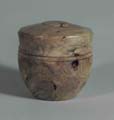Squat Box
Here is a design for what I call a 'squat box'. The blank is essentially a cube. It has the proportions of 4 to 9 lid height to total height.
Try the 2 inch diameter one below and then the 3 inch diameter one which follows.
3 Inch Diameter Squat Box
Needle Case
I make a lot of needle cases. Here is a design for a needle case with a finial at each end that will hold needles 3 inches in length. Use drill bits to bore out the cavities. I use a Forstner bit for the lid. If a needle case is going to be on display, I will turn out the dimple made by the center point of the drill bit in the lid of the box. I use a 1/4" round nose scraper for this job. For boxes that are to be used, the market does not require this refinement. To turn the end of the body, mount the body over the drill bit used to bore it out. Or you can use a piece of 3/8" diameter drill rod. Grind a 2-sided chisel point on one end of the rod and then grind two sharp points by grinding away some of the middle of the chisel point.
Box In The Shape Of A Japanese Tea Jar
This is a shape that I learned from Richard Raffan many years ago. It remains one of my favorites.
'Standard' Straight Box
Here is a design for a straight box. It is proportioned using the golden mean i.e. about 2 to 5 lid height to total height. The sides may be straight or very slightly curved as shown in the accompanying thumbnail. Note that the body height is equal to the diameter. This makes for a fairly tall box.
The following are some variations on the straight box. Notice how close the dimensions in all of them are. The 'Straight Box With Body Height 3/4 The Diameter' is the only one that is noticeably different.
'Square' Straight Box
Here is a design for a straight box where the height is equal to the diameter. It is proportioned using the golden mean i.e. about 2 to 5 lid height to total height. The sides may be straight or very slightly curved.

Straight Box With Body Height 2/3 The Diameter
This box is proportioned using the golden mean i.e. about 2 to 5 lid height to total height. The sides may be straight or very slightly curved. Notice how close the dimensions are to the 'square' box above.

Straight Box With Body Height 3/4 The Diameter
This box is proportioned using the golden mean i.e. about 2 to 5 lid height to total height. The sides may be straight or very slightly curved. Notice how close the dimensions are to the '2/3' box above. Also note the differences.

Straight Box With Body Height 0.618 The Diameter
This box uses the golden mean throughout for proportioning. The sides may be straight or very slightly curved. Notice how close the dimensions are to the 'square' box above.











